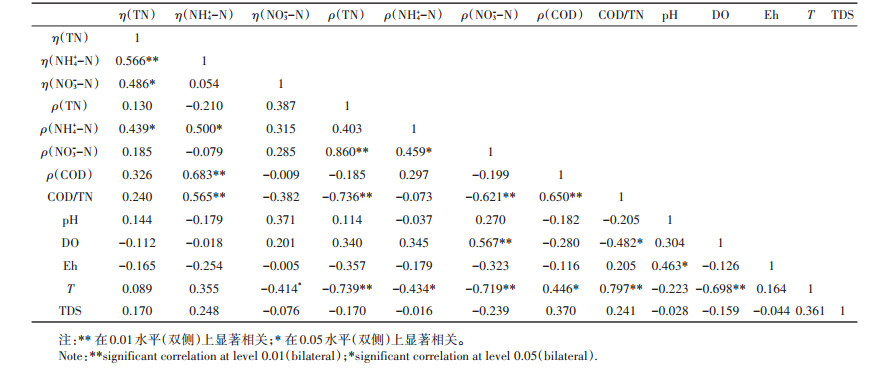湿地在截留污染物、保护生物多样性、调蓄防洪等方面起关键作用[1-2],尤其人工湿地因其管理方便、投资运行费用低、环境友好等优点而被广泛应用于处理农村生活污水、农田废水、城市生活污水出水、低污染水等[3-5],50余年的应用经验表明人工湿地是一种可靠的污水处理技术[6]。我国的人工湿地建设起步较晚,始于1987年天津环科所建设的用于处理城市生活污水的示范工程[7],随后开展了大量人工湿地建设及科学研究工作,目前已在湿地污染物净化效率及机制[4, 8-9]、湿地植物和微生物对污染物去除效率的影响[10-13]、人工湿地强化技术[14-17]等方面取得进展。潜流湿地对污染物去除效果比表流湿地好,但存在基质堵塞、吸附饱和、污染物积累等问题,而表流湿地不存在基质堵塞问题可长期运行,其上覆水处于好氧环境,硝化-反硝化作用较弱,对氮的去除效果较差,且长期运行人工湿地的截污效果未得到进一步验证[18-19]。
洱海是云南第二大高原淡水湖泊,为大理州重要饮用水源地,近10 a云南省生态环境厅发布的《云南省环境状况公报》显示,洱海水质长期维持在Ⅲ类。随着流域内社会经济发展,人类活动强度加大,尤其洱海北部农田、养殖及农村生活污水等面源污染问题日益严重,且流经该区域的罗时江、永安江、弥苴河年入湖水量大,输入的氮磷污染物约占入洱海总量的50%左右,这也加大了洱海的生态环境风险,水质开始由富营养化初期阶段向富营养化中期转变[20-22]。为保护洱海水环境,先后开展了大量人工湿地建设等生态工程措施[23-25],建成于2009年的罗时江河口湿地为削减上游面源污染物的最后屏障,在地方职能部门维护管理下,至今已正常运行10 a。本文以该湿地为主要研究对象,通过开展为期1 a的逐月现场定点监测及相关文献调研,探讨正常运行1、5、10 a后的洱海北部人工湿地氮截留的长效性及影响因子,研究结果为流域内的湿地设计、建设及管理提供参考。
1 材料与方法 1.1 研究区概况及研究方法洱海流域位于澜沧江、金沙江和元江三大水系分水岭地带,流域面积2565 km2,属亚热带季风气候,干湿季节分明,每年5月至10月为降雨期(湿季),11月至次年4月为干季。罗时江为洱海北部重要的入湖河流,全长18.29 km,平均流量1.67 m3·s-1,年均径流量0.53亿m3,占洱海总来水量的5.9%[26]。罗时江流经右所、邓川、上关3镇,流域内村落、鱼塘和农田密布,沿途的生活污水、家畜粪便、农田废水等肆意流入河流,面源污染问题突出。为削减上游河流携带的污染物,保护洱海水环境,于2009年在洱海北部建成罗时江河口湿地(100°05′ 56.41″ ~100°06′ 06.37″ E,25°56′49.59″~25°57′23.80″N,见图 1),该湿地为典型的表流人工湿地,总占地48.467 hm2,其中水域面积为44.467 hm2。
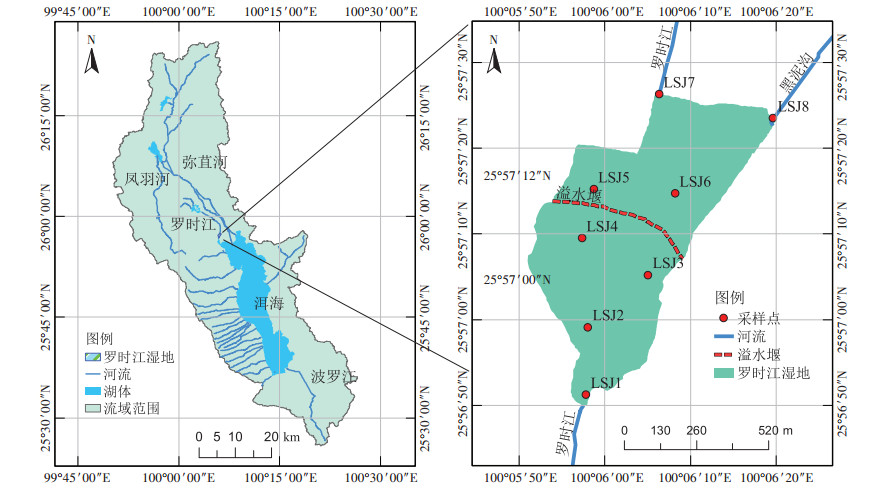
|
图 1 罗时江河口湿地区位及采样布点图 Figure 1 Location and sampling points distribution of Luoshijiang estuarine wetland |
为探究正常运行1、5、10 a的洱海北部表流人工湿地对不同形态氮的截留效率,探讨洱海流域湿地氮截留的长效性。首先,2018年8月至2019年7月在罗时江河口湿地逐月开展现场调研,获得正常运行10 a后湿地氮截留效率数据。其次,对照课题组于2014年在罗时江河口湿地按月调查成果[27],获得其正常运行5 a后湿地氮截留数据。由于缺乏罗时江河口湿地运行早期的数据,参照李丹等[28]于2017—2018年在洱海北部生态塘湿地的研究成果,主要参考数据为文献中编号为S1~S4的4个生态塘湿地,该湿地位于洱海北部入湖口,于2017年建成(正常运行1 a),距离罗时江河口湿地出水口约1.5~2.8 km,自然地理条件及进水水质等与罗时江河口湿地相近,且同为表流人工湿地,数据具有可参考性。
1.2 样点布设、样品采集与分析根据植物类型、水流状况、空间样点均匀性等布点原则,罗时江河口湿地共布设8个采样点(图 1),湿地共有2个入水口,其中LSJ7号点为罗时江入湿地口,是该湿地主要水源,LSJ8号点为黑泥沟入湿地口,该河道仅有2.8 km长,汇水面积小,除湿季降雨产生少量地表径流外常年无水进入湿地,LSJ1号点为湿地出水口,湿地出水沿罗时江河道往南流入洱海。
在2018年8月至2019年7月期间,根据GPS定位,每月中下旬采集罗时江河口湿地水样,低温保存带回实验室。2019年5月因周边农田取水导致水位急剧下降,LSJ4、LSJ5和LSJ6 3个监测点的沉积物裸露,船无法驶入,因此未采集3个监测点的样品。采样时测定水深,并利用哈纳HI 98194便携式多参数水质分析仪现场同步测定水样的pH、溶解氧(DO)、水温(T)、氧化还原电位(Eh)、总溶解固体(TDS)等理化指标。水样TN采用碱性过硫酸钾消解-紫外分光光度计法测定,NH4+-N采用纳氏试剂分光光度法测定,NO3--N采用紫外分光光度法测定,COD采用快速消解分光光度法测定。
1.3 数据处理截留率按公式(1)计算:

|
(1) |
式中:ηi为某污染物i的截留率,%;ρ0i为湿地进水中LSJ7某污染物i的浓度,mg·L-1;ρ1i为湿地出水LSJ1中某污染物i的浓度,mg·L-1;i=1,2,3,分别为TN、NH4+-N和NO3--N。
文中的数据均使用Office 2010汇总,利用Surfer 15中的Kriging插值法绘制等值线图,柱状图运用Origin 2018绘制,分别利用Canoco 5和SPSS 23进行冗余分析(RDA)和相关性分析。
2 结果与讨论 2.1 罗时江河口湿地上覆水理化指标调查期间罗时江河口湿地水深及理化参数见表 1。除2019年5月外,罗时江河口湿地常年淹水,平均水深为0.75 m,上覆水pH、DO、Eh和TDS的平均值分别为7.17±0.37、3.68±0.15 mg·L-1、108.6±6.5 mV和542.03±27.06 mg·L-1,受5月份水位下降的影响,上覆水Eh和TDS标准差较大。
|
|
表 1 罗时江河口湿地上覆水理化参数(平均值±标准差) Table 1 Physicochemical parameters of overlying water in Luoshijiang estuarine wetland(Mean±SD) |
将8个监测点ρ (TN)、ρ (NH4+-N)和ρ (NO3--N)的干、湿季的平均值分别用Surfer 15软件的Kriging插值法作图(图 2)。罗时江河口湿地湿季ρ (TN)、ρ (NH4+-N)和ρ (NO3--N)分别为1.42±0.97、0.34±0.27、0.17±0.21 mg· L-1,而干季的平均浓度分别为4.01±1.78、0.74±0.25、0.96±0.70 mg·L-1,干季的平均浓度显著高于湿季(P < 0.05)。干季ρ(TN)为《地表水环境质量标准》(GB 3838—2002)V类水限值(2.0 mg·L-1)的2倍,湿季ρ(TN)未超出IV类水限值(1.5 mg·L-1)。罗时江湿地氮的干湿季节显著差异与流域内农业生产密切相关,罗时江流域是区域内重要农业产区,调查期间干湿季主要种植大蒜和水稻等农作物。王哲等[29]的研究结果表明,水稻-大蒜种植制度下,由于冬季大蒜种植期间氮肥施用量大,向水环境排放的氮通量大,有45.4%的氮进入水环境。孙莉等[30]研究结果证实水稻-大蒜种植模式下农田土壤养分含量高,尤其罗时江流域内上关-邓川地区农田土壤的TN含量高、流失量大。此外,尽管湿季的初期雨水会携带大量污染物进入湿地,但湿季集中了罗时江流域内的主要降水,较大的水量进入湿地后稀释并稳定了污染物浓度[31];而干季降水少,生活污水在湿地入水比例上升,叠加化肥施用量增大及氮流失作用,干季湿地上覆水无机氮含量显著升高且波动较大[32-33]。
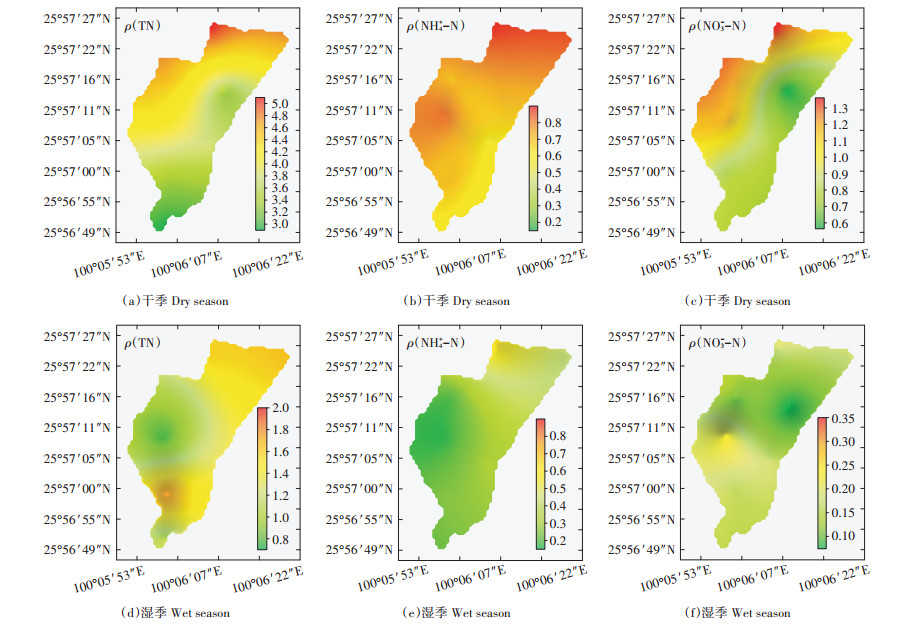
|
图 2 干湿季罗时江河口湿地上覆水氮空间分布(mg·L-1) Figure 2 Spatial distribution of nitrogen(mg·L-1)in the overlying water of Luoshijiang estuarine wetland during wet and dry seasons |
罗时江河口湿地上覆水中不同形态无机氮呈现空间异质性(图 2)。湿地北部的LSJ7为湿地进水口,上游面源污染物随地表径流进入湿地,该监测点干季ρ(TN)最大,平均为5.05 mg·L-1,显著高于出口处的LSJ1 (P < 0.05),而湿季两个监测点的差异未达到显著水平。干季LSJ7监测点的上覆水ρ(NH4+-N)的平均值为0.88 mg·L-1,高于其余监测点,但未达到显著水平;而LSJ7湿季的均值为0.62 mg · L-1,显著高于LSJ1~LSJ5(P < 0.05)。湿地上覆水ρ(NO3--N)干、湿季浓度最大值出现在LSJ7、LSJ4监测点,平均值分别为1.35、0.23 mg·L-1,单因素方差分析结果显示,干、湿季各点间ρ(NO3--N)差异未达到显著水平。总体而言,湿地出水口处LSJ1的无机氮浓度均低于入口处的LSJ7,表明已稳定运行10 a的罗时江河口湿地仍具备一定的氮截留能力。
2.3 不同形态无机氮截留的长效性正常运行10 a后的罗时江河口湿地对TN、NH4+-N和NO3--N年平均截留效率分别为(37.30±12.1) %、(34.60±17.4) %和(29.20±15.1) %(图 3),NO3--N的截留效率最低,与屈杰等[34]在运行10 a的武河人工湿地研究结果一致,但罗时江河口湿地的截留效率较武河人工湿地低。罗时江河口湿地对不同形态氮截留效率呈现极大波动,这是因为氮截留为物理、化学、生物过程的共同作用,影响因子众多[19]。运行10 a后该湿地干、湿季的平均截留效率:η(TN)分别为(37.0± 12.1) %、(37.3 ± 13.2) %,η(NH4+- N)分别为(26.2 ± 12.3) %、(43.0 ± 19.1) %,η(NO3--N)分别为(38.8 ± 15.5) %、(19.5±8.2) %,干季η(NO3--N)约为湿季的2倍,二者的差异达到显著水平(P < 0.05),而η(TN)和η(NH4+-N)的干、湿季节间差异未达到显著水平(P> 0.05)。
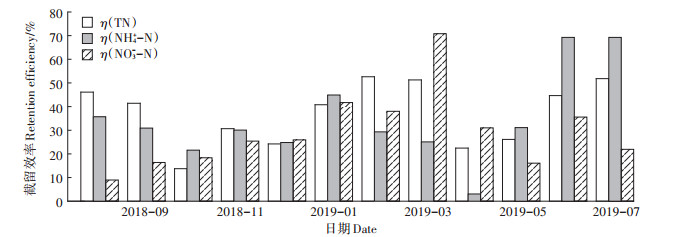
|
图 3 正常运行10 a后罗时江河口湿地TN、NH4+ -N和NO3- -N的截留效率 Figure 3 The retention efficiency of TN, NH4+ -N and NO3- -N in Luoshijiang estuarine wetland after 10 years of normal operation |
洱海北部正常运行1、5、10 a后的表流湿地对不同形态氮全年平均截留效率:η(TN)分别为(40.2± 19.6) %、(29.5±14.4) %和(37.30±12.1) %,η(NH4+-N)分别为(41.2 ± 22.9) %、(25.3 ± 16.7) %和(34.60 ± 17.4) %,η (NO3--N)分别为(40.9±20.3) %、(26.8±21.6) %和(29.20±15.1) %[27-28]。近10 a来不同形态无机氮的年平均截留效率呈现波动变化,相比运行1 a的表流湿地,运行10 a后湿地的截留效率呈下降趋势,这是由于湿地沉积物不断积累的营养盐和湿地逐渐“老化”所致[35]。而统计分析结果显示,运行1、5、10 a后不同形态氮的平均截留效率差异未达到显著水平(P>0.05),表明洱海流域表流湿地在正常运行10 a后对TN、NH4+-N和NO3--N去除率的下降趋势不显著,依然有较好的截留效果。
罗时江河口湿地上覆水中无机氮呈现显著季节性差异,不同运行时长的河口湿地对TN、NH4+-N和NO3--N的平均截留效率在干、湿两季也呈现不同的变化趋势(图 4)。洱海流域表流湿地在正常运行1、5、10 a后,干季η (TN)、η (NH4+-N)和η (NO3--N)未呈现显著差异(P>0.05),表明已正常运行10 a的洱海流域表流湿地在干季仍保持较好的氮截留效果。湿季无机氮的截留效率随运行时长呈下降趋势,统计分析结果显示η (TN)、η (NH4+-N)和η (NO3--N)差异达到显著水平(P < 0.05),表明运行10 a的罗时江河口湿地氮截留效果在湿季显著降低。干季能保持稳定的氮截留与进水氮含量高、进水量小密切相关,干季流域内大气降水少、地表径流小、湿地水力停留时间长,有利于湿地的氮截留。值得注意的是,尽管干季的截留效率随运行时长未显著下降,但运行初期表流湿地干季的截留效率远低于湿季,且干季湿地上覆水中ρ (TN)、ρ (NH4+-N)、ρ(NO3- -N)远高于湿季,尤其干季湿地出水中ρ(TN)超出Ⅴ类水限值标准,需进一步加强罗时江流域内干季的氮管控,同时强化干季湿地的氮截留能力。
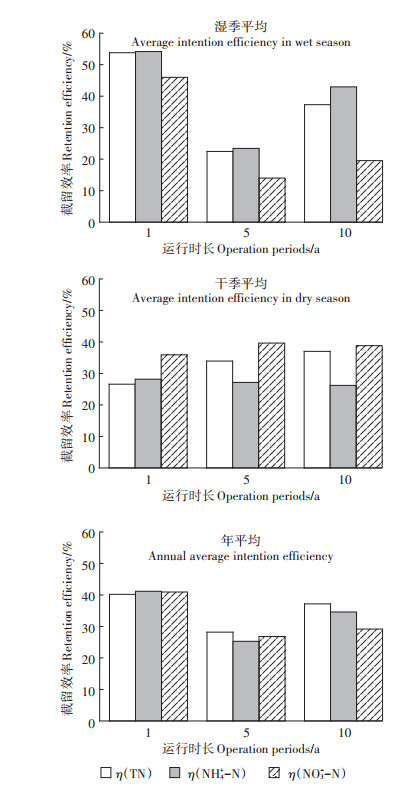
|
图 4 洱海北部不同运行时长的河口湿地不同形态无机氮截留效率对照 Figure 4 The comparison among retention efficiency of inorganic nitrogen with different forms by estuarine wetlands with different operation periods in north Erhai Lake |
湿地污染物截留机理主要包括:沉淀、过滤、挥发、吸附、植物吸收、微生物降解作用等,这些过程受到水体污染负荷、温度、氧化还原条件、运行管理方式等因素的直接或间接影响[4, 12]。基于2018年8月至2019年7月期间调查数据,利用Canoco 5进行RDA排序(图 5)。ρ (COD)、ρ (NH4+-N)、COD/TN和T箭头连线最长,是影响氮截留变化的重要因子。η (TN)、η (NH4+-N)与ρ (COD)、ρ (NH4+-N)在同一区间,箭头方向一致且夹角较小,表现为正相关关系,对η(TN)、η(NH4+-N)变化起到很好的解释作用。η (NO3--N)与(ρ TN)、(ρ NO3--N)、DO之间箭头方向一致且夹角较小,表现为正相关关系,而η(NO3--N)与T、COD/TN因子之间箭头相反,表现为负相关关系。
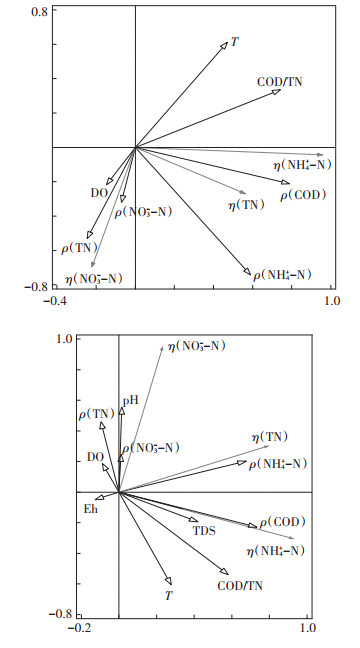
|
图 5 湿地氮截留效率与环境因子冗余分析 Figure 5 Redundancy analysis (RDA)of nitrogen retention efficiency and environmental factors of estuarine wetlands in Erhai watershed |
为进一步验证影响罗时江河口湿地氮截留的环境因子,基于Pearson相关性分析分析了η(TN)、η(NH4+-N)、η(NO3- -N)与ρ(TN)、ρ(NH4+-N)、ρ(NO3--N)、ρ(COD)、COD/TN、pH、DO、Eh、T、TDS的相关性,结果见表 2。
|
|
表 2 无机氮截留效率与氮输入及其他理化参数相关性分析 Table 2 Correlation analysis of inorganic nitrogen retention efficiency with nitrogen input and other physicochemical parameters |
罗时江河口湿地η (TN)与η (NH4+-N)、η (NO3--N)显著正相关(P < 0.01,P < 0.05),表明NH4+-N和NO3--N的去除均有利于TN的截留。η(TN)与ρ(NH4+-N)呈显著正相关(P < 0.05),说明上覆水NH4+-N含量增加有利于TN的去除,而η(TN)与ρ(NO3--N)呈正相关,但未达到显著水平(P>0.05),表明ρ(NO3--N)增加并未显著提高η(TN)。湿地中NH4+-N主要通过植物吸收、硝化、厌氧氨氧化、挥发等过程被去除,罗时江河口湿地上覆水DO、Eh和pH平均值分别为3.68 mg· L-1、108.6 mV和7.17,为氧化环境,硝化作用比反硝化和挥发作用等强烈,上覆水中NH4+-N通过硝化作用转化为NO3--N,而反硝化过程受到一定程度抑制,使得ρ(NO3--N)升高,上覆水ρ(NO3--N)与DO呈现极显著正相关关系(P < 0.01)。
除氧化还原条件外,COD/TN是影响硝化、反硝化过程的重要因子,影响着湿地硝化、反硝化过程碳源供给[13, 36-38]。由表 2可知,罗时江河口湿地上覆水η (NH4+-N)与COD/TN呈极显著正相关(P < 0.01),表明进水高COD/TN增强了湿地氮硝化作用,促进NH4+-N转化为NO3--N。而η (NO3--N)与COD/TN为弱负相关,且ρ (NO3--N)与COD/TN为极显著负相关(P < 0.01),表明罗时江河口湿地进水高COD/TN未促进反硝化作用。
温度是影响湿地氮截留的重要因子,温度在16.5~32 ℃时有利于硝化过程的进行[5, 37]。研究表明温度在15~20 ℃时,实验装置η(TN)可高达91%,而在3~6 ℃时仅为18%[37]。罗时江湿地干、湿季平均水温分别为14.16±3.78 ℃和22.90±2.91 ℃,湿季较高水温使得η(NH4+-N)高于干季,而η(NO3--N)干季显著高于湿季(P < 0.05),且ρ(NO3--N)与水温呈极显著负相关(表 2),表明湿季较高水温有利于罗时江湿地上覆水中NH4+-N向NO3--N转化,促进了硝化过程。
综上,尽管罗时江河口湿地上覆水中η(TN)、η (NH4+-N)、η(NO3--N)与DO、Eh和pH等因子未呈现显著相关性(表 2),但上覆水中DO、Eh、COD/TN和T均有利于湿地氮的硝化过程,不利于反硝化过程,从而限制TN的截留,成为湿地氮去除的制约环节,后续湿地恢复、建设及管理中应重点优化湿地中的反硝化过程,以提升氮截留效果。
3 结论(1) 罗时江河口湿地上覆水无机氮浓度呈现显著干、湿季节分异,干季显著大于湿季,因此需加强该流域干季的氮管控。湿地入水口无机氮浓度高于出水口,表明正常运行10 a后的罗时江河口湿地对无机氮仍有一定的截留能力。
(2) 洱海北部正常运行1、5、10 a后的表流湿地对不同形态氮的平均截留效率呈下降趋势,但差异未达到显著水平(P>0.05)。洱海北部不同运行时长的河口湿地氮截留随时间变化规律呈现干、湿季节分异,正常运行1、5、10 a后的表流湿地无机氮截留效率在干季未显著下降(P>0.05);而湿季无机氮的截留效率呈下降趋势,η(TN)和η(NO3--N)的下降趋势尤为显著(P < 0.05)。
(3) 冗余分析及Pearson相关性分析结果显示,湿地上覆水中DO、Eh、T和COD/TN是影响无机氮截留的重要影响因子,有利于氮的硝化过程,但抑制反硝化过程,后续湿地设计、建设及管理中应重点强化反硝化过程,以提升氮截留效果。
致谢: 感谢大理市洱海保护管理局罗时江河口湿地管理处对现场调查采样提供支持与帮助。
| [1] |
崔保山, 杨志峰. 湿地生态系统健康研究进展[J]. 生态学杂志, 2001, 20(3): 31-36. CUI Bao-shan, YANG Zhi-feng. Research review on wetland ecosystem health[J]. Chinese Journal of Ecology, 2001, 20(3): 31-36. DOI:10.3321/j.issn:1000-4890.2001.03.009 |
| [2] |
Wu S B, Lyu T, Zhao Y Q, et al. Rethinking intensification of constructed wetlands as a green eco-technology for wastewater treatment[J]. Environmental Science & Technology, 2018, 52(4): 1693-1694. |
| [3] |
朱金格, 张晓姣, 刘鑫, 等. 生态沟-湿地系统对农田排水氮磷的去除效应[J]. 农业环境科学学报, 2019, 38(2): 405-411. ZHU Jin-ge, ZHANG Xiao-jiao, LIU Xin, et al. Removal of nitrogen and phosphorus from farmland drainage by ecological ditch-wetland system[J]. Journal of Agro-Environment Science, 2019, 38(2): 405-411. |
| [4] |
Vymazal J. Removal of nutrients in various types of constructed wetlands[J]. Science of the Total Environment, 2007, 380(1/2/3): 48-65. |
| [5] |
Saeed T, Sun G Z. A review on nitrogen and organics removal mechanisms in subsurface flow constructed wetlands:Dependency on environmental parameters, operating conditions and supporting media[J]. Journal of Environmental Management, 2012, 112: 429-448. DOI:10.1016/j.jenvman.2012.08.011 |
| [6] |
Vymazal J. Constructed wetlands for wastewater treatment:Five decades of experience[J]. Environmental Science & Technology, 2011, 45(1): 61-69. |
| [7] |
Zhai J, Qin C, Xiao H W, et al. Constructed wetlands for wastewater treatment in mainland China:Two decades of experience[J]. Applied Mechanics and Materials, 2011, 90-93: 2977-2986. DOI:10.4028/www.scientific.net/AMM.90-93.2977 |
| [8] |
Lee S, Maniquiz M C, Kim L H. Characteristics of contaminants in water and sediment of a constructed, wetland treating piggery wastewater effluent[J]. Journal of Environmental Sciences, 2010, 22(6): 940-945. DOI:10.1016/S1001-0742(09)60202-3 |
| [9] |
Zhang M M, Luo P, Liu F, et al. Nitrogen removal and distribution of ammonia-oxidizing and denitrifying genes in an integrated constructed wetland for swine wastewater treatment[J]. Ecological Engineering, 2017, 104: 30-38. DOI:10.1016/j.ecoleng.2017.04.022 |
| [10] |
Stottmeister U, Wiessner A, Kuschk P, et al. Effects of plants and microorganisms in constructed wetlands for wastewater treatment[J]. Biotechnology Advances, 2003, 22(1): 93-117. |
| [11] |
李林锋, 年跃刚, 蒋高明. 植物吸收在人工湿地脱氮除磷中的贡献[J]. 环境科学研究, 2009, 22(3): 337-342. LI Lin-feng, NIAN Yue-gang, JIANG Gao-ming. Contribution of macrophytes assimilation in constructed wetlands to nitrogen and phosphorous removal[J]. Research of Environmental Sciences, 2009, 22(3): 337-342. |
| [12] |
Faulwetter J L, Gagnon V, Sundberg C, et al. Microbial processes influencing performance of treatment wetlands:A review[J]. Ecological Engineering, 2009, 35(6): 987-1004. |
| [13] |
Fu G P, Yu T Y, Ning K L, et al. Effects of nitrogen removal microbes and partial nitrification-denitrification in the integrated vertical-flow constructed wetland[J]. Ecological Engineering, 2016, 95: 83-89. DOI:10.1016/j.ecoleng.2016.06.054 |
| [14] |
Ju X X, Wu S B, Zhang Y S, et al. Intensified nitrogen and phosphorus removal in a novel electrolysis-integrated tidal flow constructed wetland system[J]. Water Research, 2014, 59: 37-45. |
| [15] |
Wu S B, Kuschk P, Brix H, et al. Development of constructed wetlands in performance intensifications for wastewater treatment:A nitrogen and organic matter targeted review[J]. Water Research, 2014, 57: 40-55. |
| [16] |
Zhi W, Ji G D. Quantitative response relationships between nitrogen transformation rates and nitrogen functional genes in a tidal flow constructed wetland under C/N ratio constraints[J]. Water Research, 2014, 64: 32-41. |
| [17] |
Vymazal J. The use of hybrid constructed wetlands for wastewater treatment with special attention to nitrogen removal:A review of a recent development[J]. Water Research, 2013, 47(14): 4795-4811. DOI:10.1016/j.watres.2013.05.029 |
| [18] |
Gorgoglione A, Torretta V. Sustainable management and successful application of constructed wetlands:A critical review[J]. Sustainability, 2018, 10(11): 3910. DOI:10.3390/su10113910 |
| [19] |
白晓慧, 王宝贞, 余敏, 等. 人工湿地污水处理技术及其发展应用[J]. 哈尔滨建筑大学学报, 1999(6): 88-92. BAI Xiao-hui, WANG Bao-zhen, YU Min, et al. Development of constructed wetland wastewater treatment technology and its application in China[J]. Journal of Harbin University of Civil Engineering and Architecture, 1999(6): 88-92. |
| [20] |
翟玥, 尚晓, 沈剑, 等. SWAT模型在洱海流域面源污染评价中的应用[J]. 环境科学研究, 2012, 25(6): 666-671. ZHAI Yue, SHANG Xiao, SHEN Jian, et al. Application of SWAT model in agricultural non-point source solution investigation in lake Erhai watershed[J]. Research of Environmental Sciences, 2012, 25(6): 666-671. |
| [21] |
赵海超, 王圣瑞, 焦立新, 等. 2010年洱海全湖氮负荷时空分布特征[J]. 环境科学研究, 2013, 26(4): 389-395. ZHAO Hai-chao, WANG Sheng-rui, JIAO Li-xin, et al. Characteristics of temporal and spatial distribution of nitrogen loading in Erhai Lake in 2010[J]. Research of Environmental Sciences, 2013, 26(4): 389-395. |
| [22] |
封吉猛, 王欣泽, 林燕, 等. 洱海流域北部入湖河流污染特征分析[J]. 净水技术, 2013, 32(5): 11-15. FENG Ji-meng, WANG Xin-ze, LIN Yan, et al. Analysis of water pollution characteristics of inflowing rivers into north of Erhai Lake basin[J]. Water Purification Technology, 2013, 32(5): 11-15. DOI:10.3969/j.issn.1009-0177.2013.05.003 |
| [23] |
叶春, 金相灿, 王临清, 等. 洱海湖滨带生态修复设计原则与工程模式[J]. 中国环境科学, 2004, 24(6): 717-721. YE Chun, JIN Xiang-can, WANG Lin-qing, et al. Design principle and engineering mode of the ecological restoration in the aquatic-terrestrial ecotone of Erhai Lake[J]. China Environmental Science, 2004, 24(6): 717-721. DOI:10.3321/j.issn:1000-6923.2004.06.018 |
| [24] |
颜昌宙, 金相灿, 赵景柱, 等. 云南洱海的生态保护及可持续利用对策[J]. 环境科学, 2005, 26(5): 38-42. YAN Chang-zhou, JIN Xiang-can, ZHAO Jing-zhu, et al. Ecological protection and sustainable utilization of Erhai Lake, Yunnan[J]. Environmental Science, 2005, 26(5): 38-42. DOI:10.3321/j.issn:0250-3301.2005.05.008 |
| [25] |
金相灿, 胡小贞, 储昭升, 等. "绿色流域建设"的湖泊富营养化防治思路及其在洱海的应用[J]. 环境科学研究, 2011, 24(11): 1203-1209. JIN Xiang-can, HU Xiao-zhen, CHU Zhao-sheng, et al. Green watershed construction strategy for prevention of lake eutrophication and its application in lake Erhai[J]. Research of Environmental Science, 2011, 24(11): 1203-1209. |
| [26] |
吕兴菊, 窦嘉顺, 杨四坤, 等.洱海流域湿地生态系统建设案例分析: 以罗时江河口湿地为例[C]//中国科学技术学会.湖泊湿地与绿色发展——第五届中国湖泊论坛论文集.长春: 吉林人民出版社, 2015: 163-167. LÜ Xing-ju, DOU Jia-shun, YANG Si-kun, et al. Case study of wetland ecosystem construction in Erhai basin: Take Luoshijiang estuarine wetland as an example[C]//China association for science and technology. Forum on lakes, wetlands and green development: Proceedings of the fifth China lake forum. Changchun: Jilin People's Press, 2015: 163-167. |
| [27] |
吕俊芳, 王书锦, 刘云根, 等. 罗时江河口湿地水质季节变化特征及评价[J]. 环境工程, 2016, 34(增刊): 845-849, 877. LÜ Jun-fang, WANG Shu-jin, LIU Yun-gen, et al. Seasonal variation characteristics of water quality and evaluation at the estuarine wetland of Luoshijiang River[J]. Environmental Engineering, 2016, 34(Suppl): 845-849, 877. |
| [28] |
李丹, 储昭升, 刘琰, 等. 洱海流域生态塘湿地氮截留特征及其影响因素[J]. 环境科学研究, 2019, 32(2): 212-218. LI Dan, CHU Zhao-sheng, LIU Yan, et al. Characteristics and effects of nitrogen interception in the ecological multi pond wetlands in Erhai Lake sub-basin[J]. Research of Environmental Science, 2019, 32(2): 212-218. |
| [29] |
王哲, 谢杰, 方达, 等. 洱海北部2种典型种植制度下农田氮污染负荷研究[J]. 生态与农村环境学报, 2013, 29(5): 625-629. WANG Zhe, XIE Jie, FANG Da, et al. Nitrogen pollution load in farmlands under two typical farming systems in the north of lake Erhai region[J]. Journal of Ecology and Rural Environment, 2013, 29(5): 625-629. DOI:10.3969/j.issn.1673-4831.2013.05.014 |
| [30] |
孙莉, 高思佳, 储昭升, 等. 土地利用方式对洱海流域坝区土壤氮磷有机质含量的影响[J]. 环境科学研究, 2016, 29(9): 1318-1324. SUN Li, GAO Si-jia, CHU Zhao-sheng, et al. Effects of land use on soil nitrogen, phosphorous and organic matter contents in flatland of Erhai Lake basin[J]. Research of Environmental Sciences, 2016, 29(9): 1318-1324. |
| [31] |
白献宇, 胡小贞, 庞燕. 洱海流域低污染水类型、污染负荷及分布[J]. 湖泊科学, 2015, 27(2): 200-207. BAI Xian-yu, HU Xiao-zhen, PANG Yan. Pollution load, distribution and characteristics of low-polluted water in lake Erhai watershed[J]. Journal of Lake Sciences, 2015, 27(2): 200-207. |
| [32] |
倪兆奎, 王圣瑞, 赵海超, 等. 洱海入湖河流水体悬浮颗粒物有机碳氮来源特征[J]. 环境科学研究, 2013, 26(3): 287-293. NI Zhao-kui, WANG Sheng-rui, ZHAO Hai-chao, et al. The sources of organic carbon and nitrogen of suspended particulate matter in inflow river of Erhai Lake[J]. Research of Environmental Sciences, 2013, 26(3): 287-293. |
| [33] |
何宗健, 蔡静静, 倪兆奎, 等. 洱海不同途径氮来源季节性特征及对水体氮贡献[J]. 环境科学学报, 2018, 38(5): 1939-1948. HE Zong-jian, CAI Jing-jing, NI Zhao-kui, et al. Seasonal characteristics of nitrogen sources from different ways and its contribution to water nitrogen in lake Erhai[J]. Acta Scientiae Circumstantiae, 2018, 38(5): 1939-1948. |
| [34] |
屈杰, 李宝, 李肖正, 等. 武河湿地碳氮净化长效性及其内源分布与释放[J]. 环境科学与技术, 2019, 42(5): 181-188. QU Jie, LI Bao, LI Xiao-zheng, et al. Long-term effectiveness of carbon and nitrogen purification of Wuhe constructed wetland and their internal distribution and release[J]. Environmental Science & Technology, 2019, 42(5): 181-188. |
| [35] |
Mitsch W J, Zhang L, Waletzko E, et al. Validation of the ecosystem services of created wetlands:Two decades of plant succession, nutrient retention, and carbon sequestration in experimental riverine marshes[J]. Ecological Engineering, 2014, 72: 11-24. DOI:10.1016/j.ecoleng.2014.09.108 |
| [36] |
Ding Y, Song X S, Wang Y H, et al. Effects of dissolved oxygen and influent COD/N ratios on nitrogen removal in horizontal subsurface flow constructed wetland[J]. Ecological Engineering, 2012, 46: 107-111. DOI:10.1016/j.ecoleng.2012.06.002 |
| [37] |
Jia L X, Gou E F, Liu H, et al. Exploring utilization of recycled agricultural biomass in constructed wetlands:Characterization of the driving force for high-rate nitrogen removal[J]. Environmental Science & Technology, 2019, 53(3): 1258-1268. |
| [38] |
Xu J H, He S B, Wu S Q, et al. Effects of HRT and water temperature on nitrogen removal in autotrophic gravel filter[J]. Chemosphere, 2016, 147: 203-209. DOI:10.1016/j.chemosphere.2015.12.136 |
 2020, Vol. 39
2020, Vol. 39




